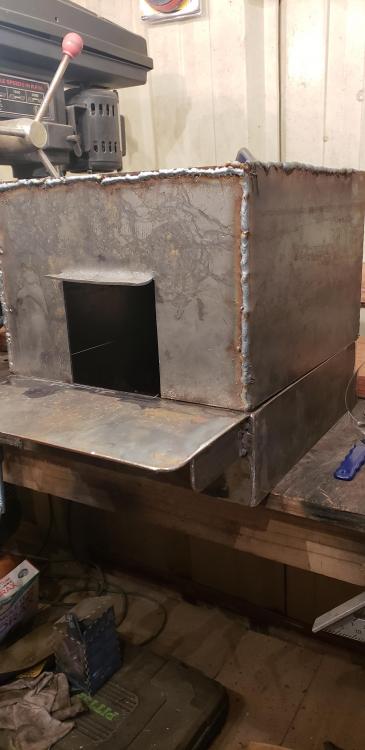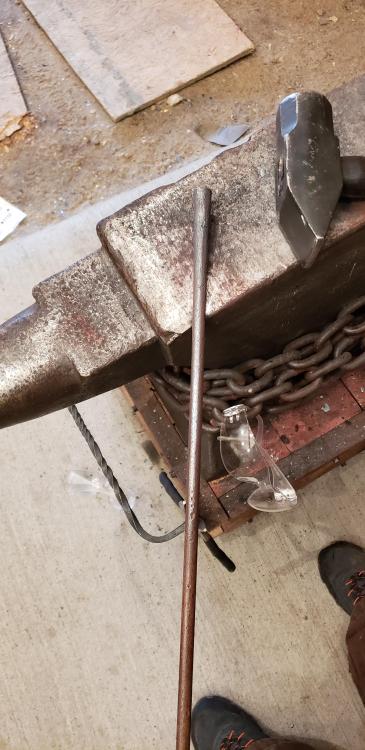
Matt Watson
Members-
Posts
33 -
Joined
-
Last visited
Profile Information
-
Gender
Male
-
Location
Tullahoma TN about an hour from Murfreesboro and Chattanooga
-
Interests
Blacksmithing, woodworking, guitar, fishing, hunting, rock climbing, camping, almost anything. I dabble in a little of everything but haven't mastered any of them.
Recent Profile Visitors
699 profile views
-
3D printed plastic burner experiments (photo heavy)
Matt Watson replied to Another FrankenBurner's topic in Gas Forges
Another FrankenBurner what about printing a fan blade like a 3 blade boat propeller that is a couple millimeters less of a diameter of the pipe so it can rotate. Would that help with what your trying to do? Just trying to figure out a way to insert it into the mixing tube and where at within the length would be the problem I see with doing this. I have a friend who had a 3d printer for a while and he printed a box with gears in it that turned and there wasn't any assembling any pieces of it it wort just as it was printed. If there was a way you could do some type of cylinder insert where the propeller was in the center and spun like the gear box my friend did and the top and bottom of it were just hollow allowing the air to flow through it turning the prop it might work. But please tell me if the theory of my concept is wrong and maybe why if you dont mind. I am new to this and trying to learn as much as I can.- 863 replies
-
3D printed plastic burner experiments (photo heavy)
Matt Watson replied to Another FrankenBurner's topic in Gas Forges
Thank you Mikey for simplifying that I understood it a little better. I like it when yall add specific scientific terms in these post so I can look them up and learn some more. I'm starting to enjoy the science behind the burners and forges / and also building them just as much as I enjoy actually forging. If I could just get my son to sit down and learn it with me that would be an amazing accomplishment for him. He stays with me for a few minutes then gets bored with it and would rather just burn something. Guess I cant blame him since he's ten and has ADD just like me.- 863 replies
-
3D printed plastic burner experiments (photo heavy)
Matt Watson replied to Another FrankenBurner's topic in Gas Forges
Ok, I do not have the intelligence yall have. Frosty you stated the paddles aren't flat and while my initial comment was to simply twist the air opening on the Mikey burner to achieve this I believe a little tweaking with scrolling pliers would be needed to get the right pitch of the blades. Also in order to get the blades to create the desired effect they would have to be on the inside diameter of the pipe I think is what you were saying Mikey. I read your comment several times and still couldn't fully understand it. could you have a smaller diameter pipe section (use a spring fuller to radius the section that you want the blades in prior to cutting) then cut the equal blade section out and twist / bend into the desired blade pitch. I state pitch since that is the term used for boat propellers. Also you could use 4 instead of three if thinking along the idea of a propeller. Although I am probably again just making things too complicated and in the end may not work. I looked at an older propane burner that just screws onto a 1lb bottle last night. It had a larger diameter flame retention nozzle than the new ones that are the same diameter as the mixing tube and you could unscrew it and separate the mixing tube and flame retention nozzle at the orifice which seemed to be a solid brass pipe. I did this while it was lit and started to see how far away from the orifice I could get it before it extinguished. I was able to get about an extra inch away from it before the flame went out. But while I got to looking at it and a new one that I have I noticed they are both the same except for the diameter of the flame retention nozzle. Both were roughly 3/8'' pipe from orifice to end and the orifice was I'm guessing but probably .010''. The older one had a 1/2'' flare retention nozzle over the mixing tube but instead of fitting flush against the other pipe it had tack welded spots or little cut outs around basically a washer with a 1/8'' center hole. The newer one has a recessed smaller washer with about a 1/8'' center hole and instead of the cutouts like the other one it looked like a crimped piece of sheet metal all the way around it in like a star pattern. Can either of yall explain to me how these work compared to the designs such as yours?- 863 replies
-
3D printed plastic burner experiments (photo heavy)
Matt Watson replied to Another FrankenBurner's topic in Gas Forges
After looking at this design and since I've been looking at yours as well and have a little experience with blacksmithing now I am wondering if you were to heat your air opening up and twisted it wouldn't it create this same effect and cut the need to cast it? I'm just guessing here but that what I'm seeing when I look as this is the slotted material left would turn and it should create a twist in them essentially making them into blades. The only issue I can think of with doing that would be keeping it perfectly aligned centered with the opposite end.- 863 replies
-
Hello Frosty, I understand completely about your thoughts on the car handles, seatbelt latches and knives. Being a police officer the past 12 years I've seen a few that couldn't make it out of a burning car and burned myself in the process of getting a guy out once. But back to the topic. So the best insulating material for forges is Kaowool but you need a hardener for longevity, and the ITC 100 isn't useful except for its radiant abilities so only a thin layer would be useful. I want to be able to keep the heat in the forge as much as possible just as everyone else. That's why I was thinking 4" of thickness. I was thinking doing that it would also keep the body of the forge cool to the touch. Doing a little more digging talking with you and others. I'm now thinking I will use the wool with rigidizer and then about 1/2" - 1" of castable and coat the lining with 1/16"- 1/8" of the ITC. But also go away from square to oval shaped. Should be interesting trying to get an oval inside a square but I may just start all over an turn that body into a wood stove to heat the shop.
- 14 replies
-
I am now starting to get a little confused with the refractory choices. I thought the ITC 100 HT was supposed to be the best stuff out there due to its insulating capabilities reflecting the heat back in and reducing the overall cost of fuel. This is the main reason I was wanting to overkill this forge I figured spend the money up front to build it right then it will save in the long run. From what I'm reading on both the Metrikote and the Plastix they are used as an insulator final coating like most have done with the ITC 100 HT. According to ITC website the 100HT can be used as a coating or a castable refractory. My interpretation of that is that you can mold a thick base etc. if you choose to do so. I did email them for clarification to be sure, but I haven't heard back as of yet. It also stated on their sight that a pint will cover 6.5-12.5 sguare feet but as Frosty pointed out a Pint wont cover but 28.88ci. So I don't have enough for what I had originally planned on doing. The 2'' Kaowool with the rigidizer will help insulate it but the castable material whatever I end up choosing will need to have an insulating property as well, and I will add a final layer 1/8'' thick of the ITC 100 HT for maximum insulation capabilities. The Kastolite 30 that Frosty recommended seems to be what I'm thinking I will go with since I have 1,008 ci to fill and according to Zoeller's site 1lb of it will cover 18 ci so I would need 56lbs to cover the area I'm wanting to do without the ITC or 55lbs with the 1/8'' coating. Or I could do 3'' of the Wool and just 1'' of the refractory. My main goal is fuel saving, then durability second. I have several of the K 26 soft bricks lying around and that's what I currently use but I was tired of replacing them. The Rigidizer I bought for the Kaowool doesn't have a name as far as brand but I got it from Clay Planet $11.95 a quart. I copied the properties of it from their site if you or anyone else is interested. Physical Properties: Color clear Solid content, % silica (approx) 28 - 29 Weight per gallon, lb (kg) (approx) 10 (4.5) Nominal density, (wet), pcf (kg/m3) (approx) 75 (1202) Maximum temperature rating, °F (°C) 2300 (1260) Freezing temperature, °F (°C) 28 (-2) Viscosity, centipoises @ 25°C 4 Specific gravity @ 25°C 1.203 pH 9.7
- 14 replies
-
Frosty thanks for the reply. I looked back on their website and it says a pint covers 6.5-12.5 sugar feet. It doesn't specify a thickness on there. I'm not sure where I got that 1" from but i thought it was on their website. They have the 100 listed as a coating material and a castable and the 296 as a top coat but it doesnt really specify the difference between the 2. I sent them an email to inquire a little more details on the differences and as to weather the 100 is actually a bulk castable or just meaning it can be shaped. But now that you have pointed these things out and suggested the kastolite 30 as an alternative. I think I may just go that route and then use the 100 as a coating like you stated. Then I'll have plenty left over to coat a ribbon burn keg build that I'm thinking about. I'm curious though since you have experimented with alot of burners along with Mikey and yalls along with Ron's seem to be the top designs. Have you ever tried a single orafic with a y split at the burner end? The reason I ask is I put a t reducer 1"×3/4" at the end of my burner the other day just to see if it would work and it did. The flames weren't as stable as a single flame but they worked, I'm assuming because when the air and fuel mixture hit the end it created an eddy current like in the ribbon burner. Do you think it would be possible to do the y split with two steps or tapered flares roughly 3 inches apart? I thought maybe a design like this could reduce the case of cold spots in some forges or maybe even step the orifice diameter up and run it like a fuel burner? I may be completely off base though.
- 14 replies
-
No typo. From what I've seen most use just a thin coating due to the high cost of the material and high shipping cost. I purchased a pint which according to the label will cover a 5ft square area 1' thick. Which would give me enough to do what I'm wanting to do with a little left over. I figured instead of a thin layer that would be more susceptible to cracking, a thicker more solid foundation of the material would possibly last longer and be much stronger. I had thought of using a cheaper castible for the entire forge then using the ITC as a coating but most that I read about crack and break apart a lot quicker than those that had used a thicker amount of the ITC.
- 14 replies
-
Hey Mikey thanks for the idea. I use a 1.5" with a 1/4 end plug drilled and tapped with a .25 MIG tip. That is centered with 4 1/4 ×20 bolts. The mixing tube is 8" and the flare cone when outside my current forge is a 3/4×1" reducer but the way I have it in my current forge it goes into the soft fire brick halfway and the last inch of it is ground to a taper creating the cone. That's what gave me the idea for casting the new one. I'll have to look back and see the step design your referring to and see what to use and try it on my burner before I start this new one. A step would be alot easier to do and hotter is always better well maybe not anyways!
- 14 replies
-
I need some opinions. I have finished the shell of my new forge and will soon be starting to fill it with the insulation. I know its over kill but I'm using 2''Kao Wool with hardener to help support the 2'' ITC 100 HT. The outside dimensions are 14L x 13W x 13H. The final inside dimensions will be 14x5x5 350ci total for a 3/4'' single burner Ron Reil design (might change to a ''Mikey burner'' if I can get the time to go ta a buddy's machine shop to build it). I have been thinking of casting the flare cone into the refractory instead of a standard hole for it to fit down in. I'm thinking the mixing tube will be inserted through the top and 2'' of hardened Kao Wool then the end of the tube would come in contact with the start of the refractory and sit flush against it. The first 1/2'' - 1'' of the refractory would be cast at the 3/4 diameter of the tube then the last 1'' -1.5'' of refractory would be flared as the cone shape ( I thought I would just use a piece of plastic from a milk jug glued or tapped together as the mold to form the refractory around) . I'm thinking doing it this way would allow for me not to have to change flare cone periodically due to heat exposure and cycling. I've included a picture of the shell, material thickness is 1/8''. For those of Y'all that have more experience than me (probably everyone on here) would this work? Would you change anything? What length would you cast the flare cone 1'' or 1.5'' or would it matter? I would just like to have some other people opinions / expert advice before I proceed any further. I can change the interior design if needed or something would work better. I also wondered if maybe an oval shaped interior would work better than rectangular? Or maybe even Bowl shaped? The base is separate from the top so I can shape it any way that I want and for ease of maintenance. Thanks in advance!!
- 14 replies
-
Dan I took my classes at Lynchburg forge. There really isn't a name for it but the gentleman that runs the shop and teaches the classes is Bruce Gillies. Quite an amazing guy with a lot of experience. He doesn't charge anything to come there you can give a donation to help with the purchase of coal which he just recently started but you don't have to give anything. The man loves the craft and just genuinely like to teach it seems like. I was lucky to have stumbled across it and it's actually not far from my house. I'm sure you will have a great time at Ken's. I haven't been but I recently purchased his rapid tong bundle to save time and money as far as making more of my own (I spent 6 hours making my first pair). His customer service is exceptional and really has a great product at a really fair price. If you have bought any I would highly recommend them. You basically get to do all the finish work on them that requires the same steps in making them from scratch but saving yourself hours of the work and cost of fuel at the same time.
-
Milling off anvil face...
Matt Watson replied to kevsauce's topic in Repairing and Modification to Anvils
ThomasPowers I'm not familiar with 4340 I'll have to look that one up I pretty much know nothing when it comes to metallurgy. As far as my anvil I bought it online and had it shipped to me. I did look at pictures but at the time I knew nothing about anvils except the old ones that were forged were supposed to be the best of the best along with hand crank blowers and post vices. That was my general understanding at the time. I still think my anvil is superior in alot of ways compared to others that I have seen in person now that I have located people in my area with the same interest. But either way I have decided I'm definitely not going to do anything to it except maybe make a plate for the top to straighten longer stock. Or I may just save up and get a flat one that is around a hundred pounds or three RR track if I can find a piece I haven't had any luck with that in my area. -
Milling off anvil face...
Matt Watson replied to kevsauce's topic in Repairing and Modification to Anvils
Swedefiddle by swail your referring to the low dished spot? If so I do use this section for straightening to within probably 1/8 of an inch but anything closer than that I have to resort to other methods. Maybe I just need more experience and practice with my anvil. I just know that I dont have to work as hard on an anvil that has a flat face. The one at my local group forge is flat and I dont have a problem with it. The instructor said he welded it then flattened it with a grinder and he has probably 50 years of experience and told me to do that with mine. I didnt want to argue with him or anything of the sort since he is nice enough to instruct us for free at his home and he definitely knows alot, but I was shocked when he suggested to me after what I had read about it welding ruins anvils rebound and hardness. But I also tend to look at alot of different things before I jump into something. -
Milling off anvil face...
Matt Watson replied to kevsauce's topic in Repairing and Modification to Anvils
Frosty this is the only one I have on my phone at the moment I can post another one tomorrow. I know what you mean about wanting the best of things I'm bad about that that's why I wanted this anvil I thought it was going to be the best and it is amazing I think and the only reason I want a flat surface is for straightening things that are longer than the with in the front part that is pretty flat. The corners aren't much of a concern I wish they were in better shape but I have a few spots that I wouldn't want to change due to the fact that they actually help in some things. Kozzy I actually thought about that and took a flat piece of stock and have been laying it on top to straighten things but I cant really hit hit because of the bounce so I had thought about essentially making a lid to sit over the entire face but I didn't know if it would bounce as well. Making a top plate hardy tool sounds like it may make it work. Has anyone had any success with this that you know of and if so what hardness and steel would be best for this purpose? Something between 56 and 60 maybe so maybe a plate of 1075, 1085, or o1 I guess maybe the steel type itself wouldn't matter as much as the hardness level too hard it breaks or too soft and it dishes. Also if a hardy hole plate was used would there need to be something between the plate and the face like a rubber mat or a lead sheet? And Glenn thats originally what I wanted to do but it just frustrates me not being able to straighten pieces having to use a vice or some other way to straighten something longer than 5". Thanks guys for the advice! -
Milling off anvil face...
Matt Watson replied to kevsauce's topic in Repairing and Modification to Anvils
I have been scrolling through these trying to figure out what to do to mine if someone who knows more than me wants to offer their insight it would be appreciated. My anvil is a 1830-1850 Hill anvil 201# that was forged with the hardy and prichet hole. I bought it a couple years ago and paid $1200 for it ( my first anvil) also my only anvil. I have maybe 100 hrs of use on it but I just got my forge going a few weeks ago. It is in good shape for the most part but there is not a sharp edge on it anywhere because of chips not major problem but a little sharper on the corners would be good. and there is a sag in the main hammer section you would use as well as towards the hardy and pritchet hole. basically I have about a 2''x4'' section that is flat. Im not worried about being level but flat would be nice. Is fly milling the face an option for me without ruining the hardness. I don't want to weld at all on it. I was just thinking of milling down .025-.075'' to flatten it enough for more useability. anyone know some more information that they care to share about the forged Hill anvils?




